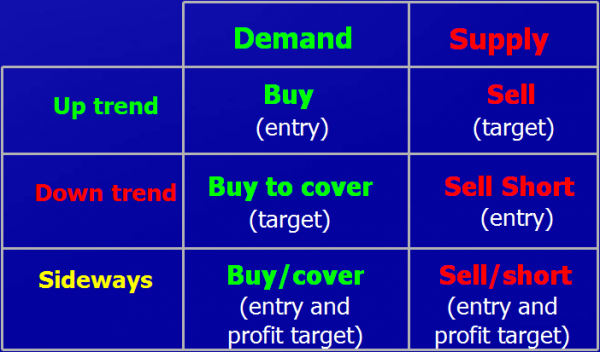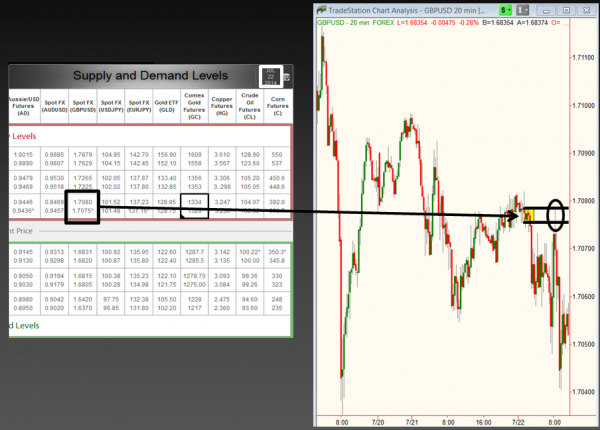![]()
Once and a while, I will get an email from someone saying, “I like your supply and demand strategy but what strategy should I use in trending markets?” This person thinks our patented core strategy is only for markets going sideways where they use supply and demand to pick tops and bottoms. What this person doesn’t realize is that we use our core supply and demand strategy for any market, time frame, and market condition. We always want to buy at price levels where demand exceeds supply (where banks and institutions are buying) and sell at price levels where supply exceeds demand (where banks and institutions are selling) when those price levels have significant profit zones around them. I also get emails from time to time suggesting that I don’t like trend trading or something to that nature; this could not be further from the truth. I love market trends as that is where we get paid as a trader or investor. We want to enter the market at market turns when the risk is low and be in the market when prices trend (move) which again, is where we profit. How people enter into trending markets is where I disagree.
The grid above is a good summary of what action to take in each of the three types of trend/market conditions. The ideal trade for the Online Trading Academy trader is to buy a pullback to a fresh demand level in the context of a larger time frame uptrend. Conversely, to short a rally in price to a fresh supply level in the context of a larger time frame down trend. For an example of trading with the trend, let’s look at a trading opportunity in the GBPUSD from our supply/demand grid on July 22, 2014.
First, notice the entire chart, it is clearly in a down trend when looking at the smaller time frames. The series of lower highs and lower lows suggests a down trend meaning more supply than demand is coming into this market at current price levels. The larger time frame which is not shown here is very clearly in a down trend in this market, during the time of this trade. At Online Trading Academy, we do employ our “real time” trend analysis but that is beyond the scope of the article. The supply level on the grid was the entry with a protective buy stop above the supply level and a profit target much lower. Our odds enhancers told us that banks were likely selling GBPUSD at that level which means we want our academy students selling at that level. But, who would buy at that supply level?
Online Trading Academy Supply/Demand Grid: GBPUSD – July 22, 2014
When price rallied up to that supply level, we would be selling short but again, who would we be selling to, who is the buyer? The buyer in this case would be making three key mistakes that only a novice retail trader would make. First, they would be buying after a rally in price which is never a good thing. Second, they would be buying into a price level where our strategy determined banks are selling the GBPUSD (supply exceeds demand). Last but not least, they would be all this bullish action in the context of a downtrend. The laws of supply and demand ensure that this buyer will lose most of the time taking this action which means the odds are stacked in the sellers favor.
Trading with the trend is great but you have to know exactly where to buy into an uptrend and sell in a downtrend. Fresh supply and demand levels offer you the lowest risk, highest reward, and highest probability entry into a trending or non – trending market which is why we focus on them so much. To identify quality and acceptable levels, know your odds enhancers.
Hope this was helpful, have a great day.
Note: All information on this page is subject to change. The use of this website constitutes acceptance of our user agreement. Please read our privacy policy and legal disclaimer. Opinions expressed at FXstreet.com are those of the individual authors and do not necessarily represent the opinion of FXstreet.com or its management. Risk Disclosure: Trading foreign exchange on margin carries a high level of risk, and may not be suitable for all investors. The high degree of leverage can work against you as well as for you. Before deciding to invest in foreign exchange you should carefully consider your investment objectives, level of experience, and risk appetite. The possibility exists that you could sustain a loss of some or all of your initial investment and therefore you should not invest money that you cannot afford to lose. You should be aware of all the risks associated with foreign exchange trading, and seek advice from an independent financial advisor if you have any doubts.
Editors’ Picks
EUR/USD edges lower toward 1.0700 post-US PCE

EUR/USD stays under modest bearish pressure but manages to hold above 1.0700 in the American session on Friday. The US Dollar (USD) gathers strength against its rivals after the stronger-than-forecast PCE inflation data, not allowing the pair to gain traction.
GBP/USD retreats to 1.2500 on renewed USD strength

GBP/USD lost its traction and turned negative on the day near 1.2500. Following the stronger-than-expected PCE inflation readings from the US, the USD stays resilient and makes it difficult for the pair to gather recovery momentum.
Gold struggles to hold above $2,350 following US inflation

Gold turned south and declined toward $2,340, erasing a large portion of its daily gains, as the USD benefited from PCE inflation data. The benchmark 10-year US yield, however, stays in negative territory and helps XAU/USD limit its losses.
Bitcoin Weekly Forecast: BTC’s next breakout could propel it to $80,000 Premium

Bitcoin’s recent price consolidation could be nearing its end as technical indicators and on-chain metrics suggest a potential upward breakout. However, this move would not be straightforward and could punish impatient investors.
Week ahead – Hawkish risk as Fed and NFP on tap, Eurozone data eyed too

Fed meets on Wednesday as US inflation stays elevated. Will Friday’s jobs report bring relief or more angst for the markets? Eurozone flash GDP and CPI numbers in focus for the Euro.
RECOMMENDED LESSONS
Making money in forex is easy if you know how the bankers trade!
Discover how to make money in forex is easy if you know how the bankers trade!
5 Forex News Events You Need To Know
In the fast moving world of currency markets, it is extremely important for new traders to know the list of important forex news...
Top 10 Chart Patterns Every Trader Should Know
Chart patterns are one of the most effective trading tools for a trader. They are pure price-action, and form on the basis of underlying buying and...
7 Ways to Avoid Forex Scams
The forex industry is recently seeing more and more scams. Here are 7 ways to avoid losing your money in such scams: Forex scams are becoming frequent. Michael Greenberg reports on luxurious expenses, including a submarine bought from the money taken from forex traders. Here’s another report of a forex fraud. So, how can we avoid falling in such forex scams?
What Are the 10 Fatal Mistakes Traders Make
Trading is exciting. Trading is hard. Trading is extremely hard. Some say that it takes more than 10,000 hours to master. Others believe that trading is the way to quick riches. They might be both wrong. What is important to know that no matter how experienced you are, mistakes will be part of the trading process.


